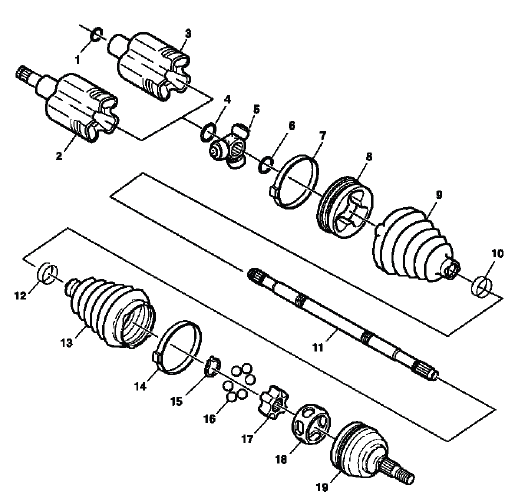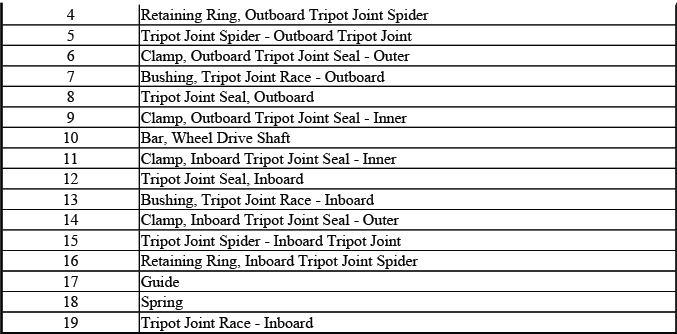Buick Enclave: Specifications, Diagnostic Information and Procedures
SPECIFICATIONS
FASTENER TIGHTENING SPECIFICATIONS
Fastener Tightening Specifications

ADHESIVES, FLUIDS, LUBRICANTS AND SEALERS
Adhesives, Fluids, Lubricants and Sealers

COMPONENT LOCATOR
FRONT WHEEL DRIVE SHAFT DISASSEMBLED VIEWS

Fig. 1: Identifying Wheel Drive Shaft Components


REAR WHEEL DRIVE SHAFT DISASSEMBLED VIEWS

Fig. 2: Wheel Drive Shafts Disassembled Views - Rear


DIAGNOSTIC INFORMATION AND PROCEDURES
CLICK NOISE IN TURNS
A constant velocity joint which is worn or damaged may cause a click noise during turns. This may be more apparent while simultaneously turning and accelerating. This click is caused by wear and/or damage to the constant velocity joint bearings and/or races. Commonly, this damage or wear is caused by the loss of lubricating grease from the constant velocity joint and the entry of foreign material or contaminates.
Carefully inspect the wheel drive shaft seals (boots) for cuts, tears or other damage which may allow the lubricating grease to escape. The loss of this grease will cause damage to the wheel drive shaft constant velocity joint in a very short period of time. If the seals (boots) do not exhibit evidence of lubricant loss or damage, remove the wheel drive shaft from the vehicle and rotate the constant velocity joint by rotating in a circular motion. The action of the constant velocity joint should be smooth and even. If any binding and/or roughness is felt while performing this inspection, the constant velocity joint requires replacement.
CLUNK WHEN ACCELERATING FROM COAST
A clunk noise occurring when accelerating from coast or a standing start may be caused by a worn or damaged wheel drive shaft cross groove joint. The common cause of wheel drive shaft cross groove damage is the loss of lubricating grease and/or the presence of foreign material and contaminates in the joint. This usually occurs as a result of a torn or damaged cross groove joint seal boot.
Carefully inspect the wheel drive shaft cross groove seal boot for cuts, tears or other signs of damage that may allow the loss of the lubricating grease and/or the entry of contaminates. If the seals appear intact, remove the wheel drive shaft from the vehicle and inspect the cross groove joint. Rotate the cross groove joint in a circular motion. Do not allow the cross groove spider to become disengaged from the race housing or damage to the cross groove joint will occur. The movement of the cross groove joint should be smooth and even. If any binding or impeded motion is felt, the cross groove joint requires replacement.
CLUNK NOISE WHEN ACCELERATING DURING TURNS
A clunk noise that occurs while accelerating during turning may be caused by wear and/or damage to the inboard and the outboard joints in combination. Carefully inspect the joint seals (boots) for cuts, tears or other damage. Joint seals that are damaged may allow lubricant leakage and the entry of foreign materials and contaminates. The loss of lubricant and/or the presence of contaminates can cause damage to the internal components of the joints.
If the seals (boots) are not damaged, remove the wheel drive shaft from the vehicle and rotate the joints in a circular motion. Do not allow the tripot spider to become disengaged from the housing (race). The movement of the joints should be smooth and even. If the joints exhibit any binding or inhibited movement, the joint requires replacement.
SHUDDER OR VIBRATION DURING ACCELERATION
In order to diagnose a shudder or vibration during acceleration, refer to Diagnostic System Check - Vehicle.

